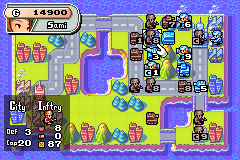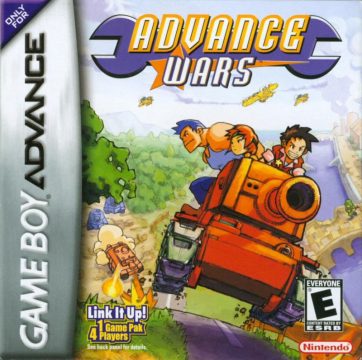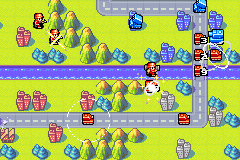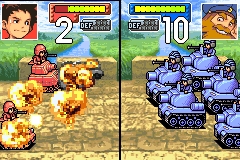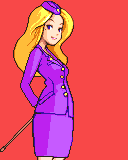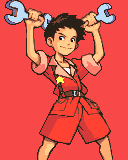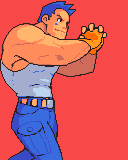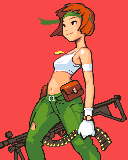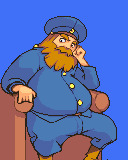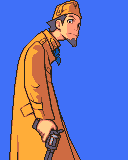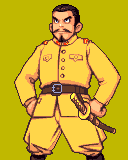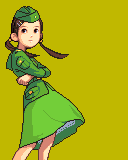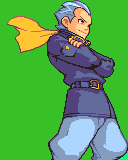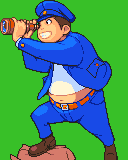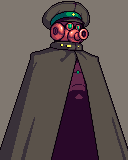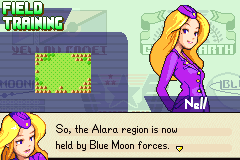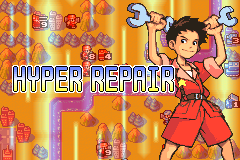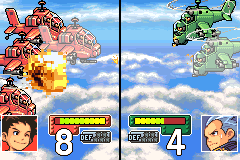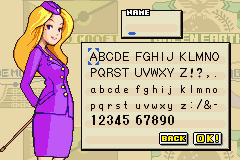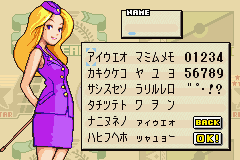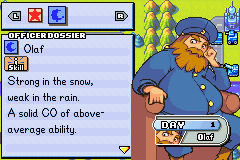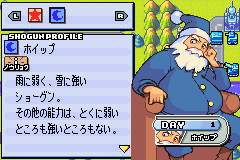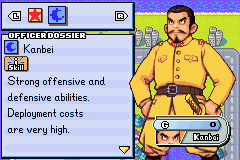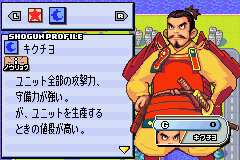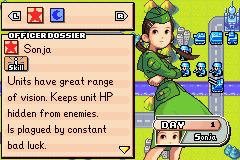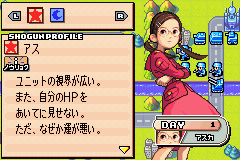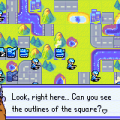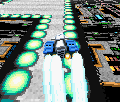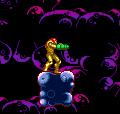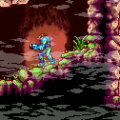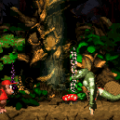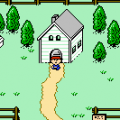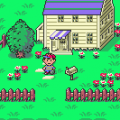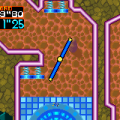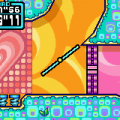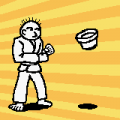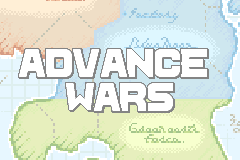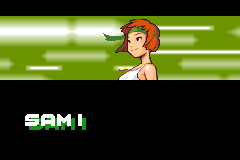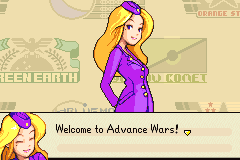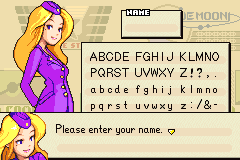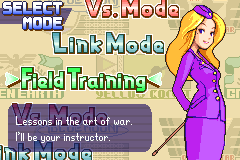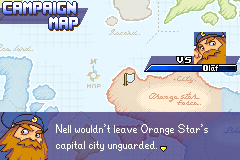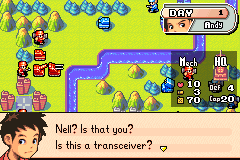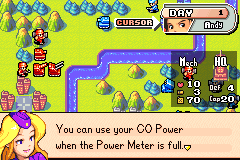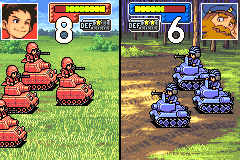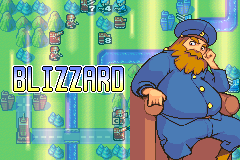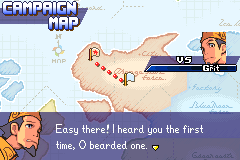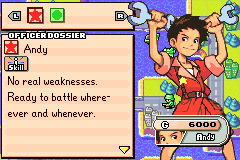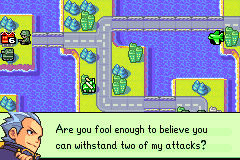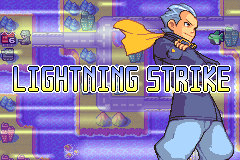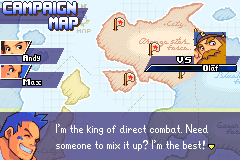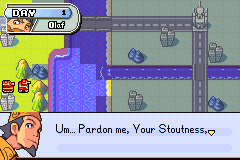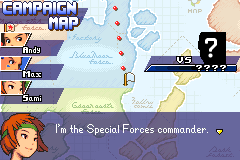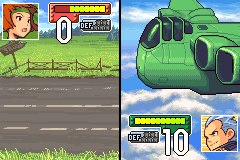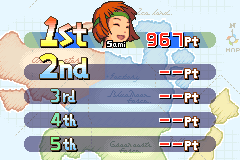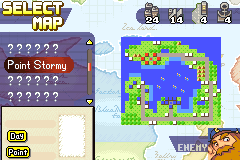While the critical acclaim for the Famicom Wars games was certainly there in Japan, the titles never made it beyond the borders. In terms of sales the games had performed adequately, though they hadn’t taken off in any particularly meaningful manner. Comparatively Intelligent System’s sister series of grid-based tactics games, Fire Emblem, had seen four entries by the release of Super Famicom Wars, with one more coming afterwards. Developed with the consideration of a visual and theme redesign that was intended to catch the attention of western audiences, three months after the launch of the Gameboy Advance, North America received its first exposure to the series with Advance Wars.
Revamping what little there was of a setting, Advance Wars takes place in a fictional world known as Wars World. The four nations of Red Star, Blue Moon, Yellow Comet, and Green Earth still exist, but what ties there are to prior entries are thin. Due to Western audiences having dubious feelings about red stars, the nation of Red Star was given a more orange-red hue and came to be called Orange Star outside of Japan. featuring more fine-tuned gameplay, possessing new game-play mechanics to change up how the game is played, and actually having a story in which the COs took direct part; Advance Wars is unquestionably the point where the series hit its stride.
While the units have been given another pass over, with some units going away while others merged together, as well as a global application of Caroline’s luck mechanic as a core game concept; the single largest change to the manner in which the game is played would be how COs influence the battlefield. All COs have both day-to-day adjustments that give their armies their own flavor, such as one CO having strong air units at the cost of a weak navy, or another that has weak direct-combat units but devastating indirects. Beyond this however, are the CO Powers. As battles wage and losses accrue, COs build up a meter. When full, the CO Power can be unleashed, with each CO drastically changing the state of play in their own way. Whether it’s healing all of one’s own units, caking the battlefield in snow by changing the weather to inhibit enemy movement, or doing global damage to all enemy units, no two COs are alike. Effective use of these powers can completely change the tide and allow for victory, while poor usage or strategy can seal one’s demise.
The visuals shift stylings once more, with things becoming a bit less cartoony in appearance though no less charming. Units instigating an engagement will approach the battle line by walking/driving/etc towards the enemy before opening fire. Portraits of the COs will respond to the situation as the condition of their units change before and after battle. Each nation’s units taking visual inspiration from real-world counterparts, with Red/Orange Star somewhat Ironically resembling the United States, Blue Moon resembling Russia, Yellow Comet being Japan, and Green Earth having a European vibe. Musically every CO has their own personal theme that plays when their turn rolls up, extensions of their personalities. The themes work rather well with the GBA’s rather infamously limited sound chip. Some themes are a bit on the weak side, there’s none that could be described as unpleasant and some of them are quite catchy.
Red Star
Nell
The Commander in Chief of Red Star, Nell guides the player through the rather comprehensive tutorial, a practical demonstration of the series’ concepts that it’s still recommended to new players to this day. Nell is polite and professional as befitting a head of state, becoming only slightly sinister when insulted. She is unlockable after completing a good chunk of the game’s content. True to her Caroline roots, Nell’s army are luckier than most and her Power heightens that luck even further, allowing her units the chance to do damage that would otherwise not be possible.
Andy
Andy is the first CO that the player will use in the campaign and is presented as a mechanical savant. He is good hearted and stupid, being the source of many jokes among the player-base. Andy’s army is entirely stock with no modifiers. His Power allows him to heal all of his units on the field instantly and for free.
Max
The second of the campaign-playable Cos, Max is loud and enthusiastic. He does one thing and he does it VERY well. All of his direct-combat units have a bonkers-high damage modifier. In exchange Max’s indirect units have reduced range. Max’s Power raises his direct damage even further and provides extra movement to his units so that they can reach targets that would otherwise be safe. In later entries his damage bonus was significantly reduced, leaving him merely ‘very good’.
Sami
Rounding out the campaign Cos is the infantry specialist Sami. To-the-point and confident, Sami rounds out the campaign team by offering a more strategic manner of play. Her soldier units are very strong and capture more effectively and her transports cover more ground at the cost of all of her non-soldier units doing less damage. Sami’s Power makes her soldiers hit even harder and travel further.
Blue Moon
Olaf
The leader of the nation, we first see Olaf as an ineffectual braggart that demonstrates strategic mistakes in the tutorial. The relationship between Olaf and Nell somewhat resembles that of Yuan and Rojenski. Like Andy his units have no modifiers, however Olaf’s army ignore snow, while struggling in Rain just as others would in Snow. Olaf’s Power forces the weather to snow, hampering the tactical and strategic movement of his opponents.
Grit
Formerly of Red/Orange Star, the easy-going Grit is the operational and behavioral foil of Max. Friends of Max and Nell, his reasons for defection are unclear. Grit’s is the indirect specialist, with all such units getting extra range, while his direct units rather lack in the might category. His Power extends the range of his indirects even further, covering tremendous distances.
Yellow Comet
Kanbei
A emperor who rules with his heart and definitely not his head, Kanbei is the leader of Yellow Comet and is characterized as being short-sighted and brash but possessed of an earnestness to do right by his people. All of Kanbei’s units have a higher deployment cost. However, all of them are stronger and more durable in exchange. His Power provides a small boost to the offense and defense of his units.
Sonja
Kanbei’s daughter and the painfully obvious brains behind the throne, Sonja is highly intelligent, patient, and resourceful. She is the intel-specialist of the game, masking from her opponents the health-condition of her units and enabling them to see further in the fog of war. Sonja unfortunately has the rather large problem of being unlucky, causing her to fail to do as much damage as others. Her Power further extends the vision of her units and reveals enemy units that would otherwise be hidden.
Green Earth
Eagle
Debatably in charge is the hot-headed and vengeful Eagle. An aviation specialist, Eagle’s air units do more damage and consume less fuel per day, his Naval units however have rather gimped damage output in turn. His Power grants all of his non-soldier units an extra turn, including freshly deployed units. This carries the downside that all of them are significantly weaker and more vulnerable during and after his turn.
Drake
While Eagle is by air, the sea is the domain of Drake who is the game’s Naval specialist. Honest and considerate, Drake is about the only person in the world able to talk sense into his aerial counterpart. Naval units of Drake enjoy greater defense and a similar fuel discount while having less damaging air units. As a further consideration, if Drake is in play it is more likely for the weather to switch to rain. His Power deals one point of damage to every opposing unit on the map.
???
Sturm
A mysterious mastermind orchestrating things from the shadows. Little is known about Sturm other than the results of his ambitions. His army ignores the costs of terrain, allowing vehicles to zoom through forests while soldiers leap across mountains with ease. In the campaign Sturm’s unit hits harder, but takes more damage. In Versus mode, this is reversed. Sturm’s Power drops a large rock on a calculated gathering of enemy units, causing very significant damage. In the campaign, this also raises the damage output of his units.
While Super Famicom Wars provided in-game documentation as reference material for how to play the game, Advance Wars features a multi-part tutorial. The tutorial is contextualized as the Leader of Red/Orange Star, Nell, training the new unseen player-insert advisor. While this is happening, the leader of Blue Moon, Olaf, begins border skirmishes that herald the oncoming war that comprises the main game. These tutorials go over basic concepts and strategies, while Olaf’s efforts demonstrate basic blunders, such as imbalanced unit composition. This also results in one of the few call-backs to prior entries by mentioning the Alara region, referring to the Alara Range map.
Map design is mostly decent, with the inclusion of unlockable maps in the ‘War Room’ function of the game. A fair number of these are classic maps from Super/Famicom Wars, while plenty more are entirely original to Advance Wars. This allows for a variety of different challenges for single player while also providing maps that are intended to be balanced for multiplayer, available both over link-cable or by simply passing the GBA around. While the equivalence of the maps is a good effort, none of them really strike a sufficient balance when higher level concepts of play are involved. Fortunately, Advance Wars and every entry after it all feature map editors, allowing players to make their own custom maps.
A further departure from the Famicom Wars origins is the manner in which engagements occur. Rather than both sides opening fire at the same time, instead the attacking unit will open fire and do damage first. Then, the defending unit will retaliate with what remains of its numbers. The result is gameplay that rewards taking initiative and making an effort to secure the first-strike, rather than turtling. Depending upon what terrain a unit is sitting on, they may well be able to retaliate harder than the aggressor could deal. This leads to very dynamic situations that necessitate tactical decisions.
Unfortunately it’s not all gravy. The price and structure of Naval units makes them functionally unusable in standard play, and COs vary wildly in their capabilities with some being ridiculously good while others are rather hum-drum with little middle-ground. The campaign’s structure, while neat on a first pass, is rather cumbersome and is weighted with considerations that preclude picking given COs for a given map. Seeing all of the maps the campaign has to offer is a chore as a result of this.
Advance Wars performed quite strongly in the west with intense favorable critical reception. While the balance for the game isn’t perfect, it’s still quite tight overall and served as a solid foundation for later titles to build upon. Supervisor and Director of later entries Kentaro Nishimura stated in an interview in later years that he holds this as a point of pride after having run so many balance passes that the game was only shipped when the higher-ups forced the issue, though the publication of this interview is questionable and this statement may have referred to Advance Wars: Dual Strike.
Advance Wars is attributed as having shifted Nintendo’s perceptions of the western audience and paving the way for Fire Emblem to make its way outside of Japan. At the time they did not feel that western interests would resonate with a game of such intricate complexity. There is an irony to be found in that the game’s release was delayed in Japan due to a conflict with neighboring game Game Boy Wars 3. Western release wasn’t originally planned and it took some doing on Nintendo of America’s part to convince the release. Meanwhile the title never actually shipped on its own in Japan, as its late 2002 release believed to have been delayed due to the September 11th terrorist attacks. It wouldn’t see its own shores until the release of the sequel, in which they were sold as a two-for-one bundle in 2004. This hindered the series rather heavily in Japan, leaving the majority of interest in the west.
Many of the designs of the COs were changed in Japan, where they are called Shoguns (“Generals”). The Japanese versions are a little more cartoonish, with their Western counterparts trying to keep some semblance of military professionalism while still looking colorful. (Pictures from The Cutting Room Floor.)
Screenshot Comparisons
Nell / Catherine
Olaf / Whip
Kanbei / Kikuchiyo
Sonja / Asuka
